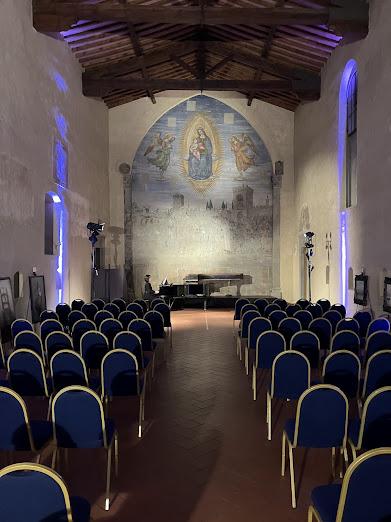Today we walked across Florence to the Ponte Vecchio, which we had seen briefly on our first tour of the city several days ago. Translated as the “Old Bridge,” it is a medieval stone bridge dating to 1345, which replaced several even older bridges spanning the Arno River at this site. It was the only bridge spared from destruction by bombing during World War II, and is notable for all of the shops built along it, mostly jewelers and art dealers these days.
As you approach it on the Via Por Santa Maria, you barely realize it is a bridge because of the shops along both sides. We continued along the road on the other side of the bridge and explored the south bank of the Arno, eventually finding a tiny café that served pizza. These older cafés are remarkable; they often having domed brick ceilings and are hundreds of years old. After lunch, we crossed back over the Arno on the Ponte Santa Trinita looking back at the "Old Bridge."
I was still not feeling the best, so I returned to the Studio Michelangelo for a short afternoon nap while Martha explored the area. I ventured out when she sent me a text message from the Biblioteca della Oblate, a library just a couple of blocks to the east. “I’m having an iced latte. Join me if you want to. The library is magnifico!” The library, located in a converted convent, was indeed magnificent, and I found her in the café on the top floor where I joined her and had a cappuccino. The view from here was beautiful, looking out over rooftops to the Duomo just a block away.
Martha had purchased tickets on-line months ago for a performance of the Three Tenors in a small, historic church on the other side of Florence, which is where we went that evening, taking a taxi that arrived at our doorstep and deposited us just down the street from the venue near the Piazza Santa Croce. We were early and had some time to explore that area as well, having a glass of wine at a sidewalk café before the performance.
The original Three Tenors have not sung in 20 years, but consisted of Luciano Pavarotti, Plácido Domingo, and José Carreras. These three tenors were equally impressive, and were accompanied by a lovely woman on the piano and an older musician playing an antique mandolin, as well as some ballet dancers. It was a wonderful evening, made even more memorable by the venue, the Oratorio di Santa Maria Vergine Della Croce al Tempio. Originally a Templar hospital in the Middle Ages, the building was occupied by a Florentine brotherhood founded in 1343. The architecture was simple and beautiful, and the acoustics were just perfect.
No trip to Italy would be complete without some opera!





No comments:
Post a Comment